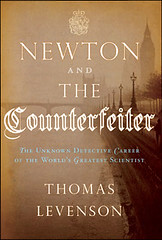
About UsThe Numismatic Bibliomania Society is a non-profit organization promoting numismatic literature. For more information please see our web site at coinbooks.org SubscriptionsThose wishing to become new E-Sylum subscribers (or wishing to Unsubscribe) can go to the following web page link MembershipThere is a membership application available on the web site Membership Application To join, print the application and return it with your check to the address printed on the application. Membership is only $15 to addresses in the U.S., $20 for First Class mail, and $25 elsewhere. For those without web access, write to: David M. Sundman, Secretary/TreasurerNumismatic Bibliomania
Society AsylumFor Asylum mailing address changes and other membership questions, contact David at this email address: dsundman@LittletonCoin.com SubmissionsTo submit items for publication in The E-Sylum, just Reply to this message, or write to the Editor at this address: whomren@coinlibrary.com
BUY THE BOOK BEFORE THE COINYou won't regret it! |
- WAYNE'S WORDS: THE E-SYLUM NOVEMBER 15, 2009
- THE ASYLUM VOLUME 27, NO. 3 PUBLISHED
- THE E-SYLUM AVAILABLE ON THE AMAZON KINDLE READER
- KOLBE SALE #111: THE STACK FAMILY NUMISMATIC LIBRARY
- AUCTION: SELECTIONS FROM HADRIEN RAMBACH'S NUMISMATIC LIBRARY
- MORE NUMISMATIC BOOK TRANSLATIONS BY DANE KURTH
- ONLINE UPDATE: AMERICAN NUMISMATIC AUCTIONS BY MARTIN GENGERKE
- ONLINE MAGAZINE: MINT ERROR NEWS
- BOOK PROJECT: PORTRAITS ON ROMAN COINS
- BOOK REVIEW: NEWTON AND THE COUNTERFEITER BY THOMAS LEVENSON
- SOME NOTES ON NUMISMATIC BOOKS
- ITALIAN MAKER OF PAPAL AND RELIGIOUS MEDALS: LORIOLI FRATELLI
- DID WOMAN REALLY FIND A CENT OF GOLD?
- SUPPORTING THE MEDALLIC MEANING OF CLICHÉ.
- PRESIDENT OBAMA'S CHALLENGE COINS
- ALAN WEINBERG ON JAMES J. CURTO
- BRITISH MUSEUM SEEKS KEEPER OF THE DEPARTMENT OF COINS AND MEDALS
- ARTICLE: SNIFF TEST TO PRESERVE OLD BOOKS
- WAYNE'S NUMISMATIC DIARY FOR NOVEMBER 10, 2009
- ROYAL MINT £5 CROWN COIN KEEPS BIG BEN STRIKING ON TIME
- ANDY WARHOL'S "200 ONE DOLLAR BILLS" SELLS FOR $43.7 MILLION
- MORE ON BANK NOTE FIRM SECURENCY'S BRIBERY
- VIDEO: HOW TO USE A BOOK
- FEATURED WEB PAGE: ROMAN NUMISMATIC GALLERY
WAYNE'S WORDS: THE E-SYLUM NOVEMBER 15, 2009
Philippe de Henaut writes:
This is just an observation I've made over the last couple of months . . . It seems every week you introduce a few more subscribers but the bottom line never seems to change: "We now have 1,269 subscribers". Are we really losing as many as we are gaining each week?
 Well, subscribers come and go for a number of reasons. Mostly, we lose subscribers because of too many bounced emails to their address. This can happen when someone switches to a new email address. Often people will resubscribe at their new address but forget (or not bother) to remove their old address. So the system purges the old address after getting too many bounces. Sometime people explicitly unsubscribe, but that's fairly rare - most new subscribers remain indefinitely. So you numbers go up and down, but over time the trend has always been upwards, and this week is more typical than recent weeks have been.
Well, subscribers come and go for a number of reasons. Mostly, we lose subscribers because of too many bounced emails to their address. This can happen when someone switches to a new email address. Often people will resubscribe at their new address but forget (or not bother) to remove their old address. So the system purges the old address after getting too many bounces. Sometime people explicitly unsubscribe, but that's fairly rare - most new subscribers remain indefinitely. So you numbers go up and down, but over time the trend has always been upwards, and this week is more typical than recent weeks have been.
Among our new subscribers this week are S. Stewart and Robert Martin. Welcome aboard! We now have 1,270 subscribers.
Last week I made a mistake composing George Kolbe's ad: the illustration of Flanagan's 1933 $20 photo is not part of the Green album lot. Sorry! And thanks again to John Salyer for assisting with images this week.
This week we open with some NBS news - the latest edition of our print journal will soon be arriving in member's mailboxes. In numismatic literature auction news, George Kolbe provided information on the Stack Family Library sale, and Hadrien Rambach sells selections from his library in a December 8th Paris sale.
There's yet more on numismatic literature this week - a new update to Martin Gengerke's book on American Numismatic Auctions, a book project on Roman portrait coins, and a new review of Newton and the Counterfeiter. To learn about Obama's Challenge Coin, Warhol's $43 million silkscreen and How to Use a Book, read on.
Wayne Homren
Numismatic Bibliomania Society
THE ASYLUM VOLUME 27, NO. 3 PUBLISHED
David Yoon, Editor of our print journal The Asylum writes:
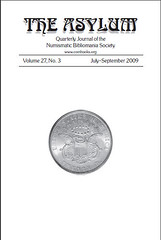
- David Stone - The Mysterious Mr. French, Revealed at Last
- Benjamin Keele - Thoughts on Preserving Digital Numismatic Literature
- Roger S. Siboni - The Infamous Head Left/Plow Right New Jersey Coppers
- John W. Adams - Lot 88, a True Incunable
- David D. Gladfelter - Katen's "Pots and Pans" Fixed-Price List
John Adams' cryptically-titled article is about a piece of numismatic literature related to James Mease and Joshua Francis Fisher. Adams writes:
Noted physician, scientific thinker, and author, James Mease (1771-1846), was one of Philadelphia's most prominent citizens. In numismatic circles he remained virtually unknown until recently rediscovered as the author of "the first truly numismatic article published in America" (Eric P. Newman, The Asylum, Summer, 1992, page 4), an article first printed in 1821 and revised and expanded in the 1834 edition present here. Joshua Francis Fisher, also of Philadelphia (1807-1873), was a respected author and historian.
There is a membership application available on the club web site at www.coinbooks.org/club_nbs_member_app.html .
To join, print the application and return it with your check to the address printed on the application. Membership is only $15 to addresses in the U.S., $20 for First Class mail, and $25 elsewhere. -Editor
THE E-SYLUM AVAILABLE ON THE AMAZON KINDLE READER
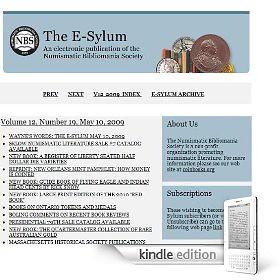
For more information, see: www.amazon.com/The-E-Sylum/dp/B0029XFPL0
KOLBE SALE #111: THE STACK FAMILY NUMISMATIC LIBRARY
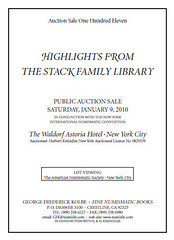 On January 9th, 2010, George Frederick Kolbe/Fine Numismatic Books will offer for sale at public auction highlights from the remarkable numismatic library carefully assembled over seven decades by the New York numismatic firm founded by brothers Morton and Joseph and ably carried on by Norman, Benjamin, Harvey, Susan, and Lawrence Stack.
On January 9th, 2010, George Frederick Kolbe/Fine Numismatic Books will offer for sale at public auction highlights from the remarkable numismatic library carefully assembled over seven decades by the New York numismatic firm founded by brothers Morton and Joseph and ably carried on by Norman, Benjamin, Harvey, Susan, and Lawrence Stack.
For over fifty years, the fabled American portion of the library has resided in antique bookcases lining one wall of Harvey Stack's office, and along the opposite wall as well. Other portions of the library were, for many years, located throughout the main floor of the firm's New York City retail location at 123 West 57th Street and many of the great classic works on ancient and foreign coins and medals were carefully arranged on the second floor in the Coin Galleries offices.
Covering virtually all aspects of numismatics and replete with rarities, it is one of the finest working libraries on numismatics ever formed in the United States.
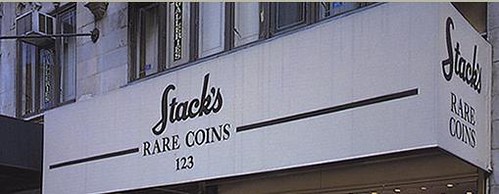
Key works from this magnificent library will be sold at the Waldorf Astoria Hotel in New York City in conjunction with the New York International Numismatic Convention this coming January. The profusely illustrated catalogue will be arranged in two parts: 190 lots of rare and classic works on American coins, medals, and tokens, and 210 key works on ancient, medieval, and modern numismatics.
The auction will also feature 100 lots of duplicates from the American Numismatic Society Library, offered as lots 401-500 in a separate catalogue. Copies of both catalogues may be reserved by sending $35.00 to George Frederick Kolbe, P. O. Drawer 3100, Crestline, CA 92325. Telephone: (909) 338-6527; Fax: (909) 338-6980; Email: GFK@numislit.com. The catalogue will also be accessible free of charge several weeks before the sale at the firm's web site: www.numislit.com.
Lot viewing will be held at the American Numismatic Society, 75 Varick Street, 11th Floor, New York, NY 10013. On Thursday, January 7th, lot viewing will be from 8 AM until 7 PM and on Friday, January 8th, from 8 AM to 8 PM. The auction itself, as previously mentioned, will be held at the Waldorf Astoria Hotel, 301 Park Avenue between East 49th & 50th Streets, New York, NY 10022.
Some American highlights include: the Stack firm's own complete bound set of their auction sale catalogues, comprising an unparalleled source of data on rare American coins, medals, tokens, and paper money; a photographic record of the fabled collection of $2.50, $5.00, and $10.00 United States gold coins from the collection of Colonel E. H. R. Green, housed in three handsome leather-bound volumes and original inventories and financial details of the collection; inventories of the incomparable Louis Eliasberg collection; most of the Chapman brothers auction sale catalogues issued with original photographic plates; classic works on large cents from the library of legendary collector Henry Hines, often filled with letters and research notes assembled by the "Big Three of the Big Cents": Hines, Howard Newcomb, and George Clapp.
Also featured are long runs of classic nineteenth and early twentieth century coin auction sales, including many great rarities; the 1915 United States Coin Co. sale of the Granberg collection, with 7 photographic plates; complete sets of The Numismatist (including the first six volumes), the American Journal of Numismatics, Frossard's Numisma, and Scott's The Coin Collector's Journal; deluxe leather-bound editions of various classic Stack's sales; unique Lyman Low bid books;
J. N. T. Levick's own annotated copy of his April 27-29, 1865 coin collection (postponed to May 28, 1865 due to the assassination of President Lincoln), one of only twelve specially issued; a large paper copy of Hickcox's 1858 "Historical Account of American Coinage"; etc.
Among classic works on ancient and foreign numismatic topics to be featured in the January 2010 Stack sale are: a complete original set of Georgii Mikhailovic's monumental work on Russian coins, including part 2 of Peter the Great, bound in thirteen volumes; classic Russian coin sales; key works on ancient numismatics including runs of the classic Danish and other Sylloge Nummorum Graecorum series, Haeberlin on Aes Grave, Gnecchi on Roman medallions, Mazzini, Hunter, RIC, Ars Classica sales, etc. Classic sets on medieval and modern German numismatics include Hoffmeister on Hesse, Dannenberg on Saxony, Bahrfeldt on Marienburg, and Fiala on Brunswick, among others. Included as well is a set of Corpus Nummorum Italicorum and classic works on Renaissance medal.
A second Stack Family Library sale is planned for Spring 2010. Highlights among the sale of 100 duplicate numismatic works from The American Numismatic Society include: classic European auction sale catalogues featuring ancient coins, among them Rhousopoulos, Montagu & Ponton d'Amécourt Roman gold, Bunbury, Lockett, Ratto Byzantine, and others; Browning's original 1925 Early Quarter Dollars of the United States; key works on Islamic coins including Nützel's 1898-1902 Katalog der Orientalische Münzen and Miles' Numismatic History of Rayy; a handsome set of Montagu sales of English coins and medals; a nine volume set of Sestini's Lettere e Dissertazioni Numismatiche from the Newell library; Waddington's classic four part work on the Greek coins of Asia Minor; the rare 1925 W. W. C. Wilson sale of American and Canadian coins and medals, with photographic plates; and other key works.
AUCTION: SELECTIONS FROM HADRIEN RAMBACH'S NUMISMATIC LIBRARY
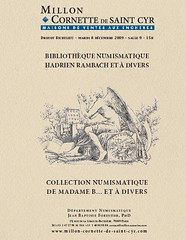 Jean-Baptiste Forestier writes:
Jean-Baptiste Forestier writes:
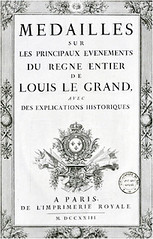
MORE NUMISMATIC BOOK TRANSLATIONS BY DANE KURTH
 We recently discussed a numismatic book translation by
Dane Kurth, administrator of the online auction archive service Wildwinds.com - Lisa Weidauer's 1975 book Probleme der frühen Elektronprägung (Problems in Early Electrum Coinage).
We recently discussed a numismatic book translation by
Dane Kurth, administrator of the online auction archive service Wildwinds.com - Lisa Weidauer's 1975 book Probleme der frühen Elektronprägung (Problems in Early Electrum Coinage).
At my request Dane forwarded an image of the cover of the original book, and she added a note about some additional translations she's made available. Great work - thanks! -Editor
It may interest your readers to know of some (free) translations (from French and German) which I have done lately and which are free to download:
1). Ruzicka: The Coinage of Serdica (original was German, 1915) Includes Plates and a lot of additional images with the permission of the owners, plus a Moushmov list and several variations of coins:
www.archive.org/details/Ruzicka_The_Coinage_Of_Serdica_English_528
2) Maerkl: The Coinage of Claudius II (original was German, 1894) Includes some images e.g. from wildwinds. A truly great and extremely interesting work. Some varieties added to the listings.
www.archive.org/details/MarklTheCoinageOfClaudiusIiEnglishTranslation
3) Pflaum: The "Three Emperor" Coinage of Carausius (original was French, 1959) Includes some coin images not in the original.
www.archive.org/details/English_Translation_Pflaum_
Carausius_Three_Emperor_Coinage
To read the earlier E-Sylum article, see: WEIDAUER TRANSLATION PROJECT COMPLETE (www.coinbooks.org/esylum_v12n44a05.html)
THE BOOK BAZARRE
ONLINE UPDATE: AMERICAN NUMISMATIC AUCTIONS BY MARTIN GENGERKE
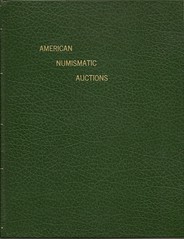 For years I've received requests to update my work, American Numismatic Auctions. Time, and a somewhat limited audience, have made a new edition impractical. However, with the growing acceptance of Adobe's PDF format for document distribution, and the easy availability of free software for viewing PDF documents, a new "edition" of my work is once again possible.
For years I've received requests to update my work, American Numismatic Auctions. Time, and a somewhat limited audience, have made a new edition impractical. However, with the growing acceptance of Adobe's PDF format for document distribution, and the easy availability of free software for viewing PDF documents, a new "edition" of my work is once again possible.
Within a week or so the three volumes of my original work will be available in a single PDF file. It will be updated – however, I no longer have as great a source of current catalogs, so many sales of the past few years will be missing.
I've decided to make this file available as a FREE download for all. It can be downloaded at the Numismatic Bibliomania Society site, at Krause Publications, and other sites. If you don't have a PDF reader, Adobe's PDF reader is free, and there are numerous other free readers available at various download sites such as www.filehippo.com.
I welcome any and all comments, changes, corrections, and additions – the more everyone helps, the better future editions will be. I can be reached at gengerke@aol.com. Enjoy!
ONLINE MAGAZINE: MINT ERROR NEWS
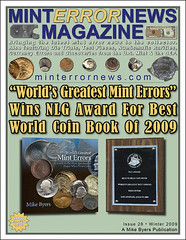 Mint Error News Magazine is a free magazine about error coins, which is published quarterly on the Web by Mike Byers. The magazine, which has run to more than 200 pages in recent issues, is cram-packed full of photos and information about all kinds of mint errors. A typical issue of Mint Error News features a cover story about a major new discovery that Byers has made. Byers is credited with an amazing number of major discoveries, and has probably brought more major error coins to market than anybody in the business, although Fred Weinberg might be pretty close!)
Mint Error News Magazine is a free magazine about error coins, which is published quarterly on the Web by Mike Byers. The magazine, which has run to more than 200 pages in recent issues, is cram-packed full of photos and information about all kinds of mint errors. A typical issue of Mint Error News features a cover story about a major new discovery that Byers has made. Byers is credited with an amazing number of major discoveries, and has probably brought more major error coins to market than anybody in the business, although Fred Weinberg might be pretty close!)
To read the complete article, see: Mint Error News Magazine (coins.about.com/od/errorcoinsdievarieties/qt/mint_error_news.htm)
BOOK PROJECT: PORTRAITS ON ROMAN COINS
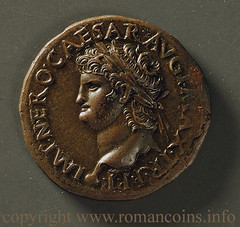 The www.romancoins.info team is currently working on a image collection of superior quality portraits of Roman Emperors and their families on Roman coins to form the base of an exciting book project available end 2010 to the Numismatic public.
The www.romancoins.info team is currently working on a image collection of superior quality portraits of Roman Emperors and their families on Roman coins to form the base of an exciting book project available end 2010 to the Numismatic public.
Images submitted must be of coins EF or better of exceptional portrait style, regardless of nominal. Images of obverse and reverse are needed, however only the obverse will be shown enlarged.
The project will consist of ca. 500 highest quality Roman coins available with the finest style portraits. Images will be to the biggest part presented in large full page size in a book of ca. DINA4 paper size.
For more information, see: Book Project: Portraits on Roman Coins (www.romancoins.info/Book%20on%20Portraits.html)
BOOK REVIEW: NEWTON AND THE COUNTERFEITER BY THOMAS LEVENSON
Bill Eckberg writes:
I thought your readers might be interested in a hard science journal's review of what is essentially a numismatic story. Of course, Newton did have a career outside of coin production
After the Glorious Revolution of 1688, in which King James II of England was overthrown by a union of Parliamentarians led by William of Orange, the English government found itself in dire financial straits. It had joined the War of the Grand Alliance against France in 1689, and was struggling to fund its army in a conflict that was to last for another 8 years. To make matters worse, the country was suffering from a lack of good coinage.
As Thomas Levenson explains in his engaging book Newton and the Counterfeiter, the government turned to an unlikely hero to save the nation from financial calamity — Isaac Newton.
An unlikely appointee for the role, he was at that time enjoying fame as the author of Principia Mathematica, his seminal work on the foundations of physics, and had just embarked on a radical change of career as a politician.
Although the job had been treated as a sinecure by most of his predecessors, Newton took it on with vigour. He masterfully oversaw the great re-coinage and, after overcoming his initial revulsion, prosecuted with relish the clippers and ‘coiners', or counterfeiters, who were partly responsible for the disarray of the country's currency. It wasn't long before his role brought him up against the arch-counterfeiter and forger, William Chaloner, whose skill and success in faking French pistoles (gold coins) and English guineas had quickly taken him from poverty to riches.
The book documents the entertaining relationship between these two geniuses and the different worlds they inhabited. Although their story is well known to historians of science, Levenson's account adds substantially to our knowledge of the social and political background against which it played out. The author manages to unpick many of the tangled and morally ambiguous webs that made up the metropolitan counterfeiting culture of that era, and shows — impressively, given the scant sources available — how Chaloner pulled off many of his brazen schemes.
It is an enthralling tale.
SOME NOTES ON NUMISMATIC BOOKS
Regarding Haxby's 1988 four-volume United States Obsolete Bank Notes, 1782-1866 in CD format, Joe Boling writes:
I bought Haxby when it was published, and hardly touched it (because I was still collecting Japan), so when the second edition was announced, I let Fred Schwan sell my set. Then the second edition never happened, and I started collecting counterfeits, of which there are thousands in Haxby. So I had to buy another set from one of our prominent book dealers - a set that was not as well cared for as mine had been. Grump.
To read the earlier E-Sylum article, see: CD BOOK REVIEW: HAXBY'S U.S. OBSOLETE BANK NOTES (www.coinbooks.org/esylum_v12n45a05.html)
Regarding the reprint of the first six volumes of The Numismatis, David J. Davis writes:
I bought mine in July 1984 for $75. That is too long ago for me to remember who I bought it from. It is bound in a maroon buckram and came that way. I bought it to complete a bound set of The Numismatist that I bought at about that time.
The set included Vol. 4, Vol. 7 thru Vol. 16 and Vol. 18 thru Vol. 63. They are uniformly 3/4 bound in red and black buckram. It took me longer to find a copy of Vol. 17. Part of my problem was the fact that I had it in my mind that I was missing Vol. 27 (1915) and ended up with two extra sets of that year. Sometimes it doesn't pay to rely on your memory and not confirm the actuality.
To read the earlier E-Sylum article, see: MORE ON THE REPRINT OF THE FIRST SIX VOLUMES OF THE NUMISMATIST (www.coinbooks.org/esylum_v12n45a08.html)
Last week I quoted a Pacific Auction Galleries lot description which read:
... actual samples of California gold underneath two small Formica disks mounted on p.45.
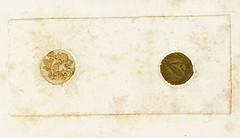
Ed Krivoniak writes:
When the 1850 Eckfeldt-Dubois book was published in 1850 Formica was not known. It was patented in 1913 as a substitute for mica and thus the name. Mica is a natural mineral that was used for many different purposes prior to the invention of plastics.
To read the earlier E-Sylum article, see: 1850 ECKFELDT-DUBOIS NEW VARIETIES WITH GOLD SAMPLES SOLD (www.coinbooks.org/esylum_v12n45a03.html)
ITALIAN MAKER OF PAPAL AND RELIGIOUS MEDALS: LORIOLI FRATELLI
Last week Chris Faulkner asked:
Does anyone have the name and location of an Italian company that apparently specialized in the production of replicas, largely of medals, I believe, sometime in the 1950s and 1960s? In his November 1968 column in The Numismatist, "Featuring Fakes," Virgil Hancock reports John Ford alerting him to expertly made high pressure cast counterfeits of 1955 doubled die one cent pieces that had been manufactured in Milan. Who is/was this company? And is this the same company that made replicas of historical and papal medals? Did they publish a catalogue of their replicas?
Leon Saryan writes:
The company in Milan that produced papal and religious medals was A. E. Lorioli Fratelli, one of their major medalists was Erminio Varisco. I have no idea, however, if they made fakes of U.S. rarities.

To read the previous E-Sylum article, see: QUERY: ITALIAN MAKER OF COIN AND MEDAL REPLICAS SOUGHT (www.coinbooks.org/esylum_v12n45a15.html)
DID WOMAN REALLY FIND A CENT OF GOLD?
Loren Gatch writes:
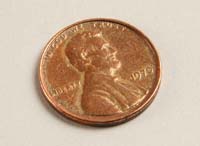 How charming it is to see this news item! Daws spent much legal money on gold to make one insignificant counterfeit cent, whereas J.S.G. Boggs monetized his own talents to create counterfeit notes worth far more than their face values. The strategies are opposite, but the aesthetic logic is identical: whatever it is made of, money is what we say it is, even if its substance (gold) or form (currency vignettes) causes us to value Daws' and Boggs' creations at rates far higher than their face values. This is an inherent property of numismatics as a practice. Any kid who finds a 1909-S VDB penny in change is only doing the same thing.
How charming it is to see this news item! Daws spent much legal money on gold to make one insignificant counterfeit cent, whereas J.S.G. Boggs monetized his own talents to create counterfeit notes worth far more than their face values. The strategies are opposite, but the aesthetic logic is identical: whatever it is made of, money is what we say it is, even if its substance (gold) or form (currency vignettes) causes us to value Daws' and Boggs' creations at rates far higher than their face values. This is an inherent property of numismatics as a practice. Any kid who finds a 1909-S VDB penny in change is only doing the same thing.
Tom DeLorey writes:
This story is highly suspect. The coin that the lady found supposedly weighed "three grams, one more than similar pennies from 1970." Small cents from 1864 to mid-1982, except for the 1943 steel cents, weighed 3.1 grams. An 18kt gold cent of the same volume as a normal 1970 cent would weigh approximately 4.5 to 5 grams.
David W. Lange of Numismatic Guaranty Corporation (NGC) concurs:
Once again the general press proves itself to be an unreliable source of numismatic information. A cent from 1970 would weigh approximately 3.1 grams when new, a bit less when worn. Where these people got their figures is a mystery.
To read the earlier E-Sylum article, see: BROOKLYN WOMAN FINDS ARTIST'S CENT MADE OF GOLD (www.coinbooks.org/esylum_v12n45a23.html)
Mark Dice, a California native, tried to sell a one ounce Canadian gold bullion coin for $50 but no one knew how much it was worth nor were they interested. Unfortunately for them, one ounce of gold is $1,100 USD.
To read the article and check out the video, see: Man tries to sell 1 ounce gold coin for $50 (www.digitaljournal.com/article/281885)
SUPPORTING THE MEDALLIC MEANING OF CLICHÉ.
First, I sincerely thank Serge Pelletier and Joe Boling for responding to my article defining cliché (which appeared in E-Sylum two weeks ago. As can be assumed, the word might be obscure to numismatists, but certainly not to medallists.
Dick Hanscom, whose inquiry launched the discussion on cliché, stated he could not find the word in Doty's or Carlton's dictionaries. True, these authors overlooked the word. Perhaps they had not encountered it that often. It is widely used, however, among medallists.
It is listed in Frey's Dictionary of Numismatic Names (page 50). Frey introduces the concept that the term is applied to electrotypes, and for the reason to show these side-by-side. I did mention this same reason in my article but did not mention electrotypes. All electrotypes are made one-sided (and joined to form a two sided item). Thus cliché could be applied to any electrotype before it is joined (but loses this distinction when so joined). Thus I omitted that concept in my article.
A TRUE cliché is what I defined in the article: Two blanks struck at the same time. I stand by every word in that article. It is this concept used by medallists.
Serge Pellletier mentioned the electrotype concept of cliché, his other definition is a lead proof or lead impression, splasher. This could be considered a lead cliché. So he is correct in his two statements in the broader use of the term.
On the other hand Joe Boling's definition of cliché's use in stereotyping is a homonym. Different meaning but spelled and pronounced the same. Here he also introduced cliché as a hackneyed phrase, another homonym of cliché. These are the etymologies you find in standard lexiconographies and dictionaries.
I did not have my tongue in cheek as suggested by Joe when I recounted the origin of the word tied to the sound of the press in striking true clichés in early days with the use of the screw press. My source is ironclad on that. After spending hundreds of hours in a pressroom in a medal manufacturing plant it is easy to connect the sound of the press to the product of a press. Thus the birth of the use of the term KLE-SHAY (the sound an early press made) with cliché.
All that does not eliminate the unique use of cliché among medallists, and I believe that is what Dick Hanscom was asking about. And that is what I wrote about in that article. I stand by every word in that article.
I appreciate two great numismatists commenting on this term. I hope they can accept the medallic concept of this word in what I defined in that article. Thank you, gentlemen.
To read the earlier E-Sylum article, see: MORE ON CLICHÉS (www.coinbooks.org/esylum_v12n44a07.html)
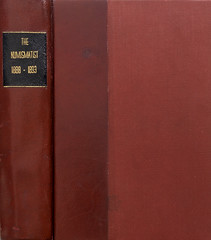

PRESIDENT OBAMA'S CHALLENGE COINS
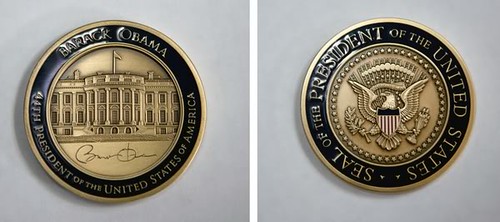
Front and back of the Presidential Coin. (Official White House Photo by Samantha Appleton)
 When I met President Obama we were at Wakefield behind the stage -- to the right of the stage -- and we're standing back stage and we're waiting for President Obama to come up and we're watching the monitor. First Secretary Arne Duncan comes up and I'm talking to him for a while. Then President Obama jogs up the steps and he's like, "Where's Tim Spicer?" and then he hands me this "challenge coin."
When I met President Obama we were at Wakefield behind the stage -- to the right of the stage -- and we're standing back stage and we're waiting for President Obama to come up and we're watching the monitor. First Secretary Arne Duncan comes up and I'm talking to him for a while. Then President Obama jogs up the steps and he's like, "Where's Tim Spicer?" and then he hands me this "challenge coin."
A challenge coin is what they give to certain individuals that have met the president or the president gives one to the students. I guess it's a challenge to see how you won't quit on your country or a challenge to you to succeed in your country. On the challenge coin, it had his name engraved in it, it said "the 44th president" and on the back it had the White House.
He asked me about college, what sports I played. Then after that he talked about how we go on stage, how he'd shake my hand and basically the protocol of how we'd go out.
Actually President Obama took all of my nerves away when I was nervous. He was so calm and relaxed that I just felt comfortable introducing President Obama.
To read the complete article, see:
Wakefield High Senior Class President Introduces President Obama
(http://www.pbs.org/newshour/extra/speakout
/us/july-dec09/timothy_09-14.html)
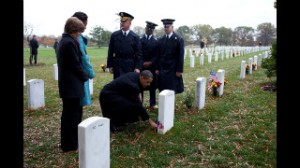 President Obama places a presidential challenge coin at the grave of Specialist Ross McGinnis who was killed in Iraq.
President Obama places a presidential challenge coin at the grave of Specialist Ross McGinnis who was killed in Iraq.
To read the complete article, see:
President Obama Visits Arlington National Cemetery
(whitehouse.blogs.foxnews.com/2009/11/11/
president-obama-visits-arlington-national-cemetery/)
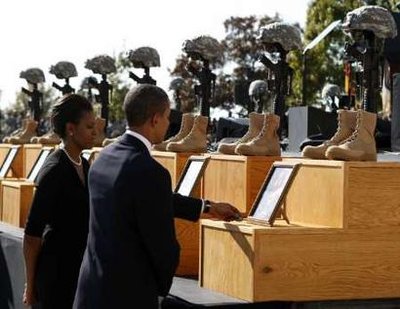 U.S. President Barack Obama places challenge coins on the memorials of victims of the November 5 shooting in Fort Hood, Texas, as first lady Michelle Obama accompanies him November 10, 2009.
U.S. President Barack Obama places challenge coins on the memorials of victims of the November 5 shooting in Fort Hood, Texas, as first lady Michelle Obama accompanies him November 10, 2009.
To read the original article, see:
Fort Hood Shooting
Unfortunately, I learned that the Smithsonian does not have any of these in their collection, nor was Dick aware of their existence. We rectified the latter, but the former is a shame - these are important and ought to be properly preserved and documented. -Editor
ALAN WEINBERG ON JAMES J. CURTO
I knew Jim Curto very well, having dealt with him extensively during the latter years of his life, staying at his home, and having bought his token collection from his son following his death. James J. Curto died about 1990 at the age of approximately 90. He lived in a middle class, single story house with his retired teacher wife Lillian, a charming woman about his age, in Grosse Pointe, Michigan.
Jim had an extensive American and foreign token collection although he specialized in Sutlers, Post and Indian trader tokens and military fort and post exchange tokens - even "modern" Viet Nam military tokens. His collection was stored at his home in every nook and cranny, near the chimney base in the basement, in the attic, etc. Those boxes of aluminum tokens stored in the cold damp attic of his Michigan home suffered extensive deterioration - some literally became aluminum "white powder".
On behalf of his family, I packed, shipped and consigned his extensive coin collection to Bowers and Merena for auction where his family realized $55,000 for a single gem 1855 gold dollar around 1992.
What kind of guy was Jim Curto? Since the early Depression he worked for and retired from a Detroit municipal dept, something like water and power, as did his son. He collected from 1929 til his death some 60+ yrs later.
He was tough to deal with - curmudgeonly, strong-willed, and suspicious (once he couldn't find a Los Angeles token of minimal value and accused me of stealing it - then he found it).
He was so wound up in his hobby that sometimes his wife and family suffered. I witnessed that. His son told me on one of my visits to his house after Jim's death, that he felt intimidated by his father all his life and neglected due to Jim's involvement in numismatics and had no interest himself in the hobby because of that.
From my 55 years in this hobby, I've seen signs of this over and over again. A family literally resents the money, time and attention a serious collector invests in his own private pursuits. That's the way it is. Guess that's why so many dealers are divorced or life-long bachelors. Their "mistress" is numismatics.
To read the earlier E-Sylum article, see: MORE ON JAMES J. CURTO (www.coinbooks.org/esylum_v12n45a20.html)
THE BOOK BAZARRE
BRITISH MUSEUM SEEKS KEEPER OF THE DEPARTMENT OF COINS AND MEDALS
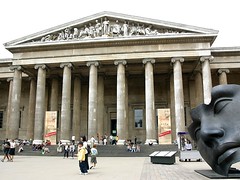 The Museum is seeking a numismatist of academic distinction to lead and manage the Department of Coins and Medals. You will be responsible for the curation of the collection of some one million coins and medals, drawn from all parts of the world since coinage was invented. You will direct the Department's academic work, ensuring the implementation of a dynamic programme of research into the collections and archaeological fieldwork abroad. You will maintain and develop cultural and diplomatic links with appropriate organisations.
The Museum is seeking a numismatist of academic distinction to lead and manage the Department of Coins and Medals. You will be responsible for the curation of the collection of some one million coins and medals, drawn from all parts of the world since coinage was invented. You will direct the Department's academic work, ensuring the implementation of a dynamic programme of research into the collections and archaeological fieldwork abroad. You will maintain and develop cultural and diplomatic links with appropriate organisations.
A recognised specialist in a relevant field, you will have experience at a senior level in a museum, university or similar institution. You will have the ability to manage and inspire the department, to participate widely in the Museum's affairs and undertake a representational role both in the UK and abroad.
For further information or a full application pack, please visit www.britishmuseum.org/jobs or email bm@pennatcs.com quoting reference 76811.
To read the complete job listing, see:
Keeper of the Department of Coins and Medals
(http://jobs.guardian.co.uk/job/933171/
keeper-of-the-department-of-coins-and-medals?RSSSearch=0&gusrc=gu_jobs_box_Film&link=Film_jbx_vac)
ARTICLE: SNIFF TEST TO PRESERVE OLD BOOKS
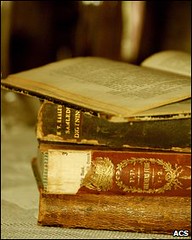 The key to preserving the old, degrading paper of treasured, ageing books is contained in the smell of their pages, say scientists.
The key to preserving the old, degrading paper of treasured, ageing books is contained in the smell of their pages, say scientists.
Researchers report in the journal Analytical Chemistry that a new "sniff test" can measure degradation of old books and historical documents.
The test picks up and identifies the chemicals that the pages release as they degrade.
This could help libraries and museums preserve a range of precious books.
The test is based on detecting the levels of volatile organic compounds.
These are released by paper as it ages and produce the familiar "old book smell".
"This unmistakable smell is as much part of the book as its contents," they wrote in the journal article.
Dr Strlic told BBC News that the idea for new test came from observing museum conservators as they worked.
"I often noticed that conservators smelled paper during their assessment," he recalled.
"I thought, if there was a way we could smell paper and tell how degraded it is from the compounds it emits, that would be great."
The test does just that. It pinpoints ingredients contained within the blend of volatile compounds emanating from the paper.
To read the complete article, see: Sniff test to preserve old books (http://news.bbc.co.uk/2/hi/science/nature/8355888.stm)
WAYNE'S NUMISMATIC DIARY FOR NOVEMBER 10, 2009
Tuesday was the night of the monthly meeting of my numismatic social group, Nummis Nova. I made my way through rush hour Capitol Beltway traffic to Tyson's Corner and pulled into the parking lot of Clyde's restaurant. The upscale restaurant is perched atop one of the few hills in the area, a pleasant oasis from the surrounding hubbub of the metro Washington D.C. area.
The buzz isn't just to the north, south, east and west, it's overhead and underground, too. A communications tower around the bend beams messages to U.S. military operations around the world, and below the surface, snaking their way through a maze of highly classified "black" telecom cables are mega machines digging a tunnel for the expansion of the D.C. Metro train network toward Dulles airport.
I knew it would be a surreal evening - D.C. sniper John Allen Muhammad was scheduled to be executed near Richmond at 9pm. It would also be the first meeting Julian Leidman would attend since his robbery last month. As noted in The E-Sylum and elsewhere, thieves had taken from his car a seven-figure inventory of rare coins and paper money.
Roger Burdette was our host, and I was looking forward to seeing everyone. A full house of twelve regulars and two guests had RSVP'd: me, Roger, Julie, Wayne Herndon, Traci Poole, Joe Levine, David Schenkman, Tom Kays, Mike Packard, Jon Radel, Chris Neuzil and Bill Eckberg, plus Bill's wife Susan and Wayne's guest S. Stewart of Abacus Coins in Ruckersville, VA.
I brought with me a binder from my numismatic ephemera collection - #40, Prospectuses. I'd made an exhibit of the material at an ANA convention, and I stored my exhibit text cards together with the items, making it nice a self-explanatory item for "show and tell". I also brought a new purchase for my library, a nicely bound copy of John H. Hickcox's 1858 classic, An Historical Account of American Coinage. Only 200 copies were printed.
Another item I brought to show everyone was a set of plasters for the 2004 Pittsburgh American Numismatic Association convention medal. I was the General Chairman for the convention, and the medal's designer, John Mercanti of the U.S. Mint, had donated three sets to raise funds for local committee expenses. I bought one of the sets.
2004 happened to be the 250th anniversary of the 1754 building of the French Fort Duquesne at the forks of the Ohio, site of modern-day Pittsburgh. The obverse shows a French soldier in front of a diagram of the five-sided fort. Mercanti signed and dated the plasters on the edge.
Tom Kays also passed around some numismatic items, including Lion Dollars and a two dollar bill.
Numismatic topics of conversation included the Switt family 1933 double eagles, and their recent slabbing by grading service NGC. I mentioned Tom DeLorey's article in the November, 2009 issue of COINage magazine, where Tom speculated that the buyer of the $7.3 million Steve Fenton specimen was the U.S. Treasury Department itself. The cost to the government would have been half that amount since the proceeds of the auction were to be shared, and buying it would ensure that the piece remained off the market.
Chris Neuzil and others at my table scoffed that the government would never be able to pull something like that off. I suggested that a Freedom of Information Act request might resolve the issue, although these can take many years to yield results. I, too, doubted that the government was the buyer, citing David Tripp's description of the buyer in his book, Illegal Tender. Chris Neuzil said that he had spoken to author Alison Frankel, and while she wouldn't reveal the name of the buyer she indicated that she has interviewed him for her book, Double Eagle. Neither of those sources hinted that the buyer was anything but a wealthy individual collector.
Maybe I had a premonition that the night would be bittersweet. At the end Traci Poole announced that it would be her last meeting - she's moving back to Idaho to be with her family. We'll sure miss her. I told her I'd hug her, "but my wife don't allow that..." She was a breath of fresh air in a group of crusty old guys (like me!) We wish her the best of luck and look forward to still seeing her at major coin shows.
There was a great deal more numismatic conversation at the table I'm sure, but it was difficult to hear beyond my immediate table. I didn't get to speak much to Julian, but it was good to see him and he was in good spirits. It was a great night and after packing up my stuff I headed out to my car and onto the roadways. My car radio brought word that John Allen Muhammad was dead. Me, I was just dead tired, but already looking forward to our next event.
THE BOOK BAZARRE
ROYAL MINT £5 CROWN COIN KEEPS BIG BEN STRIKING ON TIME
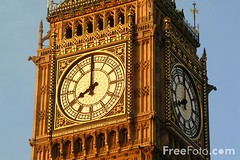 For the first time in Big Ben's 150 year history, a new £5 Crown, from the Royal Mint is being used to help London's iconic clock keep time. The 2009 Big Ben £5 Crown was today placed inside the movement of the Great Clock and will play an essential role in maintaining its famous accuracy.
For the first time in Big Ben's 150 year history, a new £5 Crown, from the Royal Mint is being used to help London's iconic clock keep time. The 2009 Big Ben £5 Crown was today placed inside the movement of the Great Clock and will play an essential role in maintaining its famous accuracy.
The coin change-over forms part of Big Ben's 150th Anniversary celebrations, with the new £5 Crown, one of the official London 2012 licensed coins, replacing some of the pre-decimal pennies which have acted as weights inside the clock since 1859. This is the first time any of the coins inside the clock have been changed.
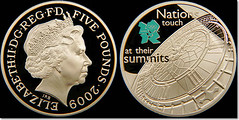
Mike McCann, Keeper of the Great Clock commented: "There is a long and historic relationship between Big Ben and the UK's coins. Few people realise the technical role the old pennies have played inside the clock.
For 150 years, coins have been used to adjust the time of the clock - adding or subtracting them effects the pendulum's centre of mass and the rate at which it swings. Using the new Royal Mint Big Ben Crown is a great way to celebrate this relationship.
To read the complete article, see:
Royal Mint £5 Crown Coin Keeps Big Ben Striking on Time
(www.coinnews.net/2009/11/12/royal-mint-5-crown-coin
-keeps-big-ben-striking-on-time/)
To read the earlier E-Sylum article, see: COIN HELPS PUT THE BONG BACK IN BIG BEN (www.coinbooks.org/esylum_v10n39a25.html)
ANDY WARHOL'S "200 ONE DOLLAR BILLS" SELLS FOR $43.7 MILLION
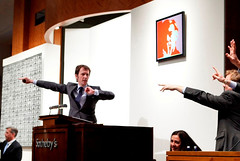 Andy Warhol's monumental masterpiece, 200 One Dollar Bills, brought a remarkable $43,762,500, soaring past the pre-sale estimate of $8/12 million. Competition was fierce. Auctioneer Tobias Meyer opened the bidding at $6 million and was immediately met with an almost unheard of response - a bid of $12 million, twice his opening bid. Five more bidders raised their paddles before the winning bid was cast by an anonymous purchaser bidding on the telephone.
Andy Warhol's monumental masterpiece, 200 One Dollar Bills, brought a remarkable $43,762,500, soaring past the pre-sale estimate of $8/12 million. Competition was fierce. Auctioneer Tobias Meyer opened the bidding at $6 million and was immediately met with an almost unheard of response - a bid of $12 million, twice his opening bid. Five more bidders raised their paddles before the winning bid was cast by an anonymous purchaser bidding on the telephone.
The Warhol was the top-selling lot in a sale of Contemporary Art that brought an outstanding total of $134,438,000, far-above pre-sale expectations (est. $67.9/97.7 million) and with all but two lots finding buyers.
"Andy Warhol's 200 One Dollar Bills is a hugely important work for American art history," said Alex Rotter, Head of the Contemporary Art Department in New York. "Not only was it one of the starting points of Pop Art, but this picture had the perfect ownership history – directly from Warhol's dealer to the legendary collector Robert C. Scull, and then from his estate sale at Sotheby's to the current owner who acquired it in 1986 for $385,000. We are immensely gratified by the extraordinary price of more than $43 million achieved for the work this evening."
In addition to 200 One Dollar Bills several other works by Andy Warhol achieved strong prices tonight. A Self- Portrait from 1965 that the artist gave to Cathy Naso, a young receptionist at The Factory, sold for $6,130,500, more than tripling the pre-sale estimate of $1/1.5 million. More than seven bidders fought for the painting, which had been kept in a closest for 42 years, giving the colors a stunning quality and freshness.
"I think I am dreaming," said Ms. Naso, who attended the auction this evening but chose to keep a low profile. "I'm simply overwhelmed, both by the amazing price and also by all the attention this painting received. After all these years in the closet, the painting has now come out and has travelled to London, to Hong Kong and has been seen all over the world. Andy has made me famous for fifteen minutes and I've come to realize that fifteen minutes of fame is more than enough."
An Untitled 1962 drawing of a roll of dollar bills, also by Warhol, that came from the collection of Leonard Newman, eventually sold for $4,226,500 against a pre sale estimate of $2.5/3.5 million with seven bidders competing.
To read the complete article, see: Andy Warhol's Iconic 200 One Dollar Bills from 1962 Sells for $43,762,500 at Sotheby's s (www.artdaily.org/index.asp?int_sec=2&int_new=34244)
To read the earlier E-Sylum article, see: WHEN ARE 200 ONE DOLLAR BILLS WORTH $10 MILLION? (www.coinbooks.org/esylum_v12n44a20.html)
MORE ON BANK NOTE FIRM SECURENCY'S BRIBERY
THE Reserve Bank's bank-note firm paid multimillion-dollar commissions to a senior Vietnamese official in an apparent breach of federal bribery laws that carry a 10-year prison sentence.
Anh Ngoc Luong received more than $5 million in so-called commission payments from the bank's firm Securency.
The payments to Mr Luong and CFTD from Securency are believed to total more than $12 million, some of which was sent to accounts in Switzerland.
The Commonwealth criminal code forbids Australian companies paying foreign officials or government-controlled firms to gain a business advantage.
Securency hired Mr Luong because of his government connections, and he has been Securency's chief government liaison in Vietnam for several years.
Since 2002 Mr Luong has played a big role in a deal in which Vietnam switched its currency from paper-based notes to those made with Securency's patented polymer formula.
To read the complete article, see:
Concern over bank firm's $5m payment
(www.smh.com.au/national/concern-over-bank-
firms-5m-payment-20091029-hnqr.html)
Nigeria's National Assembly is to investigate the country's former central bank governor over allegations he was bribed to award a contract to a company controlled by the Reserve Bank of Australia.
Nigeria's House of Representatives has passed a motion requesting the assembly's banking and justice committees investigate the Central Bank of Nigeria's previous administrators for "brazen cases'' of corruption, money laundering, reckless spending and issuing of non-performing loans.
A resolution read by representative John Halims Agoda and supported by 46 others said: ''The committees are mandated to ascertain the veracity or otherwise of the widely reported claims by the local and international media that a company, Securency, is believed to have paid millions of dollars in bribe money to Nigerian officials to secure the contract to print Nigeria's new banknotes.''
To read the complete article, see:
Nigeria to act on RBA bribe claim
(www.theage.com.au/national/investigations/
nigeria-to-act-on-rba-bribe-claim-20091022-hbfl.html)
VIDEO: HOW TO USE A BOOK
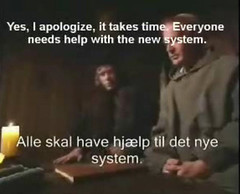
FEATURED WEB PAGE: ROMAN NUMISMATIC GALLERY
This week's Featured Web page is the Roman Numismatic Gallery, suggested by John and Nancy Wilson. They write:
This is a worthwhile site for readers of The E-Sylum. It deals with Roman Coins, Sculpture and Military Equipment. Lots of great information at your fingertips.
From the site:
This museum features a portrait gallery of Roman emperors and their families from the late Roman republic to the end of the western Roman Empire, both on coins and in sculpture. Pieces of art in marble and metal. In addition you will find Roman historical coins; countermarks on Roman coins; legionary stamps on Roman bricks; Roman military diplomas; Roman military equipment; officials, provinces, buildings, animals, gods & mintmarks on Roman coins. Shorter sections cover Greek and Celtic coinage, and also the Byzantine Empire.

www.romancoins.info

